The sassafras oil market is valued at USD 27.2 million in 2025 and is forecast to reach USD 39.4 million by 2035, representing a CAGR of 3.8%. Over the decade, the market will grow by USD 12.2 million in absolute terms, with each year contributing differently to this cumulative growth. The initial growth phase between 2025 and 2027 adds USD 2.1 million, moving from USD 27.2 million to USD 29.3 million. This accounts for approximately 17.2% of the total growth over the decade.
Early growth is supported by steady demand in flavoring, fragrances, and aromatherapy sectors, as well as expanding applications in cosmetics and pharmaceuticals. Gradual acceptance of natural essential oils in emerging economies drives early contributions to growth.
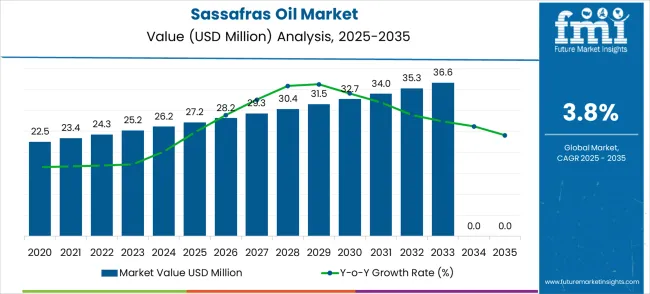
Between 2028 and 2031, the market experiences a robust growth phase, rising from USD 30.4 million in 2028 to USD 34.0 million by 2031, contributing USD 3.6 million or roughly 29.5% of the total projected growth. This phase reflects increasing utilization of sassafras oil in high-value niche applications, particularly in natural medicine, organic skincare, and specialty flavoring blends. The incremental yearly growth averages USD 1.2 million, reflecting a steady compound effect. During this phase, demand from the aromatherapy segment strengthens due to heightened awareness of wellness trends and natural therapeutic products.
| Sassafras Oil Market | Value |
|---|---|
| Market Value (2025) | USD 27.2 million |
| Market Forecast Value (2035) | USD 39.4 million |
| Market Forecast CAGR | 3.8% |
From 2032 to 2035, Sassafras Oil’s market growth continues but at a slightly moderated pace, rising from USD 35.3 million in 2032 to USD 39.4 million in 2035. This stage contributes USD 4.1 million, accounting for 33.6% of total growth over the decade. The later years reflect constant expansion due to diversification of end-use segments, including the growing demand for natural preservatives and eco-friendly flavoring agents. Regional market penetration deepens in Asia-Pacific and North America, supported by regulatory approvals and increased consumer preference for natural oils over synthetic alternatives.
Analyzing share of annual growth highlights that mid-to-late years contribute more to the market’s expansion, with years 2029 to 2035 collectively contributing over 60% of the growth. This pattern reflects a proportionate distribution where growth is driven by gradual adoption rather than sudden spikes. Segment-wise, aromatherapy and cosmetic applications are expected to contribute the largest share, while specialty flavoring segments show moderate but consistent growth. This proportion analysis highlights a stable and predictable growth curve for Sassafras Oil over the forecast period.
Market expansion is being supported by the rapid increase in specialty fragrance production worldwide and the corresponding need for unique aromatic compounds that provide distinctive olfactory characteristics and natural authenticity for premium fragrance formulations. Modern fragrance industries rely on consistent quality and scent profile reliability to ensure optimal consumer appeal including perfumery houses, cosmetic manufacturers, and specialty chemical facilities. Even minor quality variations can require comprehensive formulation adjustments to maintain optimal fragrance standards and product consistency.
The growing complexity of fragrance composition requirements and increasing demand for natural aromatic ingredients are driving demand for sassafras oil from certified suppliers with appropriate quality capabilities and extraction expertise. Fragrance manufacturers are increasingly requiring documented purity specifications and supply reliability to maintain formulation quality and product consistency. Industry specifications and quality standards are establishing standardized aromatic compound procedures that require specialized extraction technologies and trained processing personnel.
The market is entering a new phase of growth, driven by demand for natural fragrances, specialty chemical expansion, and evolving quality. By 2035, these pathways together can unlock USD 8-12 million in incremental revenue opportunities beyond baseline growth.
Pathway A -- High-Purity Product Leadership (Safrole≥90%) The Safrole≥90% segment already holds the largest share due to its superior quality and performance characteristics. Expanding purity optimization, quality certification, and premium positioning can consolidate leadership. Opportunity pool: USD 2.5-3.5 million.
Pathway B -- Premium Fragrance Applications (Perfumery & Cosmetics) Fragrance applications account for the majority of demand. Growing premium cosmetics markets, especially in emerging economies, will drive higher adoption of sassafras oil for distinctive scent profiles. Opportunity pool: USD 2.0-3.0 million.
Pathway C -- Pharmaceutical & Specialty Chemical Growth Medical and chemical applications are expanding with increasing focus on natural compounds. Oils tailored for pharmaceutical uses (high purity, certified quality, regulatory compliance) can capture significant growth. Opportunity pool: USD 1.2-1.8 million.
Pathway D -- Emerging Market Expansion Asia-Pacific and Latin America present growing demand due to rising fragrance industries. Targeting distribution networks and quality-assured supply chains will accelerate adoption. Opportunity pool: USD 0.8-1.2 million.
Pathway E -- Sustainable & Certified Sourcing With increasing sustainability requirements, there is an opportunity to promote certified organic and sustainably-sourced sassafras oil innovations. Opportunity pool: USD 0.6-0.9 million.
Pathway F -- Specialized Processing Features Products with custom distillation, enhanced purity levels, and specialized packaging offer premium positioning for high-end fragrance houses and pharmaceutical applications. Opportunity pool: USD 0.4-0.6 million.
Pathway G -- Technical Services & Application Support Recurring value from formulation consulting, quality testing, and technical support services creates long-term customer relationships. Opportunity pool: USD 0.3-0.5 million.
Pathway H -- Quality Assurance & Traceability Systems Digital quality tracking, batch certification, and supply chain transparency can elevate sassafras oil into premium specialty chemical categories while strengthening customer confidence. Opportunity pool: USD 0.2-0.4 million.
The market is segmented by purity level, application, and region. By purity level, the market is divided into Safrole≥90% and Safrole<90%. Based on application, the market is categorized into fragrance, medicine, pesticide, and other applications. Regionally, the market is divided into North America, Europe, East Asia, South Asia & Pacific, Latin America, and Middle East & Africa.
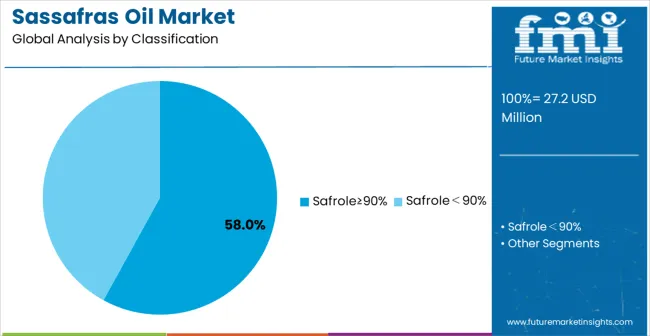
In 2025, the Safrole≥90% sassafras oil segment is projected to capture around 58% of the total market share, making it the leading purity category. This dominance is largely driven by the widespread adoption of high-purity aromatic compounds that provide superior scent intensity and formulation reliability, catering to a wide variety of premium applications. The Safrole≥90% grade is particularly favored for its ability to deliver consistent olfactory performance in both traditional and innovative fragrance formulations, ensuring aromatic excellence. Perfumery houses, cosmetic manufacturers, pharmaceutical companies, and specialty chemical facilities increasingly prefer this purity level, as it meets stringent quality requirements without imposing excessive processing complexity or sourcing difficulties.
The availability of well-established supply chains, along with comprehensive quality assurance options and regulatory compliance from leading suppliers, further reinforces the segment's market position. This purity category benefits from consistent demand across regions, as it is considered a reliable and effective solution for applications requiring high aromatic intensity and chemical consistency. The combination of quality, performance, and versatility makes Safrole≥90% sassafras oil a dependable choice, ensuring its continued popularity in the specialty chemical and fragrance markets.
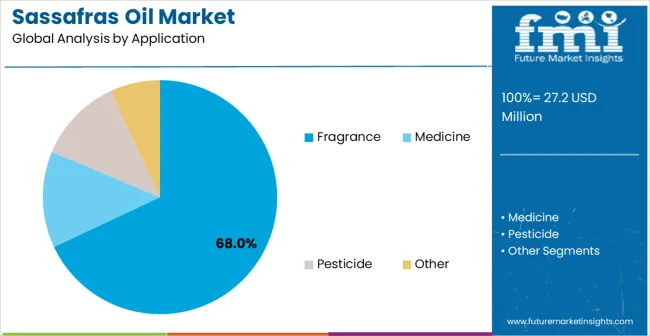
The fragrance segment is expected to represent 68% of sassafras oil demand in 2025, highlighting its position as the most significant application sector. This dominance stems from the unique aromatic properties of sassafras oil in perfumery environments, where distinctive scent profiles and natural authenticity are critical to product differentiation and consumer appeal. Fragrance applications often feature complex formulation requirements that demand specialized aromatic compounds throughout extensive product development periods, requiring reliable and consistent ingredient sources. Sassafras oil is particularly well-suited to these applications due to its ability to provide unique olfactory characteristics and natural complexity, even in sophisticated fragrance compositions.
As fragrance industries expand globally and emphasize premium natural ingredients, the demand for sassafras oil continues to rise. The segment also benefits from heightened consumer preference trends within the cosmetics industry, where manufacturers are increasingly prioritizing natural ingredients and authentic aromatic experiences as essential product features. With fragrance companies investing in natural ingredient sourcing and premium formulation standards, sassafras oil provides an essential component to maintain high-quality aromatic profiles. The growth of artisanal perfumery, coupled with increased focus on natural fragrance standards, ensures that fragrance applications will remain the largest and most stable demand driver for sassafras oil in the forecast period.
The market is advancing moderately due to increasing specialty fragrance industry development and growing recognition of natural aromatic compound advantages over synthetic alternatives in premium applications. The market faces challenges including regulatory restrictions on safrole content in certain regions, seasonal availability variations affecting supply consistency, and competition from synthetic aromatic compounds in cost-sensitive applications. Quality standardization efforts and sustainable sourcing programs continue to influence product development and market adoption patterns.
The growing development of advanced extraction and purification systems is enabling higher purity levels with improved yield efficiency and enhanced aromatic compound preservation. Advanced extraction technologies and optimized distillation processes provide superior quality control while maintaining natural compound integrity requirements. These technologies are particularly valuable for specialty chemical operators who require reliable product quality that can support extensive formulation operations with consistent aromatic results.
Modern sassafras oil suppliers are incorporating advanced green sourcing practices and traceability systems that enhance supply chain transparency and product authenticity. Integration of certified cultivation programs and optimized harvesting techniques enables superior quality assurance and comprehensive environmental stewardship capabilities. Advanced sourcing features support operation in diverse agricultural environments while meeting various sustainability requirements and quality specifications.
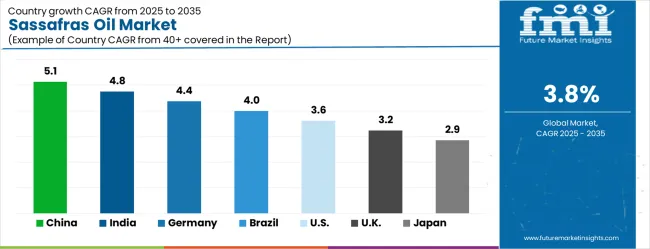
| Country | CAGR (2025-2035) |
|---|---|
| China | 5.1% |
| India | 4.8% |
| Germany | 4.4% |
| Brazil | 4.0% |
| United States | 3.6% |
| United Kingdom | 3.2% |
| Japan | 2.9% |
The market is growing steadily, with China leading at a 5.1% CAGR through 2035, driven by expanding fragrance industry development and increasing adoption of specialty aromatic compounds. India follows at 4.8%, supported by rising cosmetics infrastructure development and growing awareness of natural fragrance ingredients. Germany grows consistently at 4.4%, integrating natural aromatic compounds into its established fragrance and chemical industries. Brazil records 4.0%, focusing specialty chemical industry modernization and natural ingredient sourcing initiatives. The United States shows solid growth at 3.6%, focusing on premium fragrance applications and quality enhancement. The United Kingdom demonstrates steady progress at 3.2%, maintaining established perfumery and cosmetics applications. Japan records 2.9% growth, concentrating on quality optimization and specialized fragrance applications.
The report covers an in-depth analysis of 40+ countries; top-performing countries are highlighted below.
China is anticipated to grow at a CAGR of 5.1% between 2025 and 2035, driven by increasing demand in flavors, fragrances, and natural health products. The country’s strong herbal oil processing industry is fueling adoption in cosmetics, aromatherapy, and traditional medicine applications. China is focusing on expanding ecofriendly extraction methods to meet regulatory requirements and consumer preferences for natural products. Export demand is also rising, particularly in the food and fragrance sectors, as international buyers seek high-quality sassafras oil. Local producers are upgrading distillation and purification technology to enhance yield and quality. This growing capability positions China as a significant player in global sassafras oil markets, where innovation and quality are becoming key differentiators.
India is expected to record a CAGR of 4.8% from 2025 to 2035, supported by rising demand for natural oils in the pharmaceutical, cosmetic, and food sectors. Sassafras oil is increasingly used in Ayurvedic formulations and traditional remedies. India’s growing herbal extraction industry is investing in advanced distillation and quality control processes to meet export and domestic requirements. The country’s botanical oil exports have expanded due to rising interest in natural ingredients in European and American markets. Government initiatives promoting medicinal plant cultivation and extraction technology upgrades have boosted supply. Growing adoption of sassafras oil in niche fragrance products and natural wellness solutions further enhances growth opportunities in the Indian market.
Germany is projected to expand at a CAGR of 4.4% through 2035, driven by high demand in specialty fragrance and cosmetic industries. Sassafras oil is used for its unique scent profile in premium perfumery and flavoring products. German manufacturers are focusing on sourcing high-purity oils that meet stringent quality and safety standards. Strong demand for natural and long lasting fragrance ingredients is fueling growth, with sassafras oil gaining popularity in eco-friendly product lines. Research into new applications in wellness and therapeutic products is also expanding. Germany’s export-oriented fragrance industry further strengthens the market for sassafras oil. Continuous innovation and quality focus position Germany as a key market in Europe for natural aromatic oils.
Brazil is expected to grow at a CAGR of 4.0% between 2025 and 2035, driven by expanding use of natural oils in the food and fragrance industries. Sassafras oil is utilized in flavor formulations, traditional products, and natural wellness solutions. Brazil’s strong agricultural sector supports cultivation and extraction of sassafras, enabling competitive supply for domestic and export markets. Local manufacturers are investing in refining processes to enhance oil quality for high-value applications. Export opportunities to Europe and North America are rising due to increasing demand for natural aromatic ingredients. Brazil’s growing herbal cosmetics industry is integrating sassafras oil for its scent and perceived health benefits. These trends collectively enhance market potential over the forecast period.
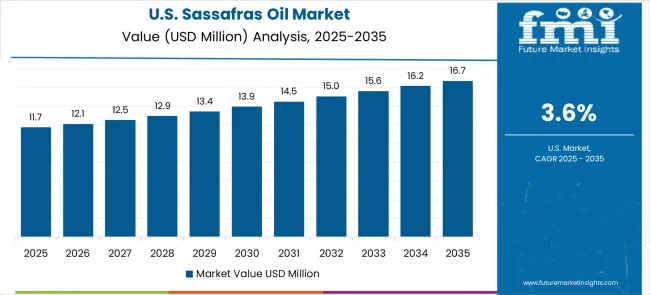
The United States is projected to advance at a CAGR of 3.6% during 2025–2035, supported by growing consumer preference for natural aromatic products. Sassafras oil is widely adopted in premium fragrances, essential oil blends, and aromatherapy products. Increasing interest in organic and plant-based wellness solutions is driving demand for high-quality sassafras oil. USA manufacturers are focusing on sourcing sustainable supplies that comply with regulatory frameworks, while investing in advanced extraction and purification technologies. The growing wellness and cosmetics market continues to create opportunities for natural oil applications. Import demand for sassafras oil has also increased, particularly for niche fragrances and natural flavor formulations. These factors ensure steady growth in the sassafras oil market in the United States.
The United Kingdom is forecasted to grow at a CAGR of 3.2% from 2025 to 2035, supported by increasing demand for natural essential oils in premium fragrances and wellness products. Sassafras oil is valued for its unique aromatic profile and is used in high-end cosmetic formulations. Growing interest in plant-based therapies and organic product lines has expanded adoption. UK manufacturers are investing in refining capabilities to ensure consistent quality and meet regulatory requirements. The fragrance industry’s export orientation offers additional growth opportunities for sassafras oil. Research into new functional uses in aromatherapy and wellness is further enhancing market potential. These trends position the UK as a market with steady but focused growth in sassafras oil demand.
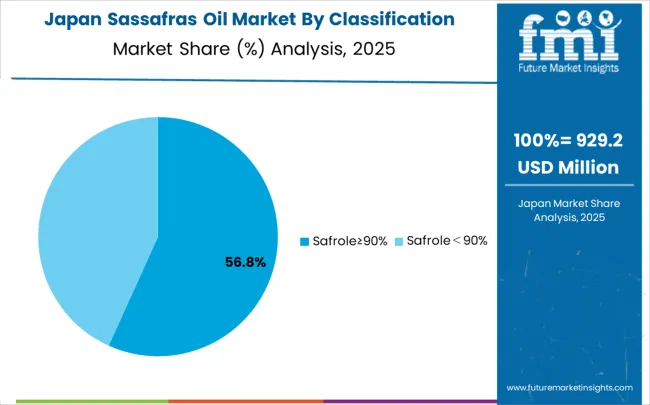
Japan is anticipated to record a CAGR of 2.9% between 2025 and 2035, supported by niche demand in cosmetics, aromatherapy, and traditional herbal products. Sassafras oil is valued for its fragrance and natural appeal in luxury cosmetics. Japanese manufacturers are investing in high-purity extraction techniques and sourcing practices to maintain quality standards. Demand is also supported by growth in natural wellness products, particularly in skincare and aromatherapy. Import reliance remains high, and Japanese firms are strengthening supply agreements to ensure consistent availability. This is complemented by government incentives to promote natural product usage. The focus on premium quality positions Japan as a market for specialized sassafras oil applications rather than mass-market consumption.
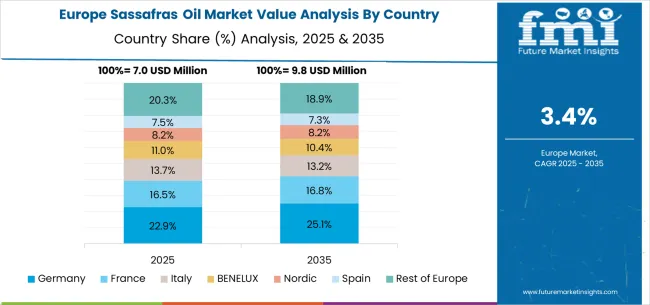
The sassafras oil market in Europe is forecast to expand from USD 7.1 million in 2025 to USD 10.8 million by 2035, registering a CAGR of 4.3%. Germany will remain the largest market, holding 31.2% share in 2025, easing to 30.8% by 2035, supported by strong perfumery infrastructure and advanced fragrance industry standards. The United Kingdom follows, rising from 22.5% in 2025 to 23.1% by 2035, driven by premium cosmetics demand and specialty fragrance applications. France is expected to maintain stability from 18.8% to 18.5%, reflecting consistent luxury perfumery investments and natural ingredient preferences. Italy holds around 12.4% throughout the forecast period, supported by traditional fragrance manufacturing and cosmetics facility upgrades. Spain grows from 8.6% to 9.2% with expanding cosmetics infrastructure and increased focus on natural aromatic ingredients. BENELUX markets maintain 4.2% to 4.0%, while the remainder of Europe hovers near 2.3%--2.4%, balancing emerging Eastern European cosmetics development against mature Nordic markets with established specialty chemical adoption patterns.
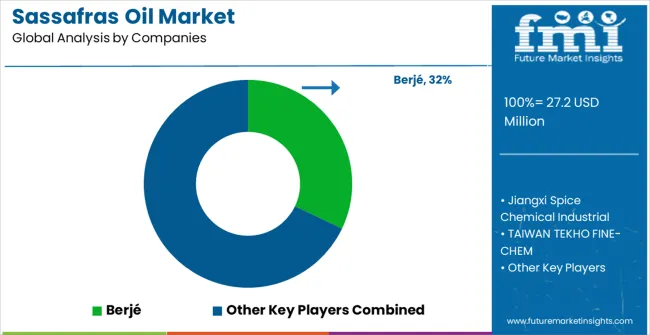
The market is defined by competition among specialized aromatic compound suppliers, fragrance ingredient companies, and specialty chemical solution providers. Companies are investing in advanced extraction technology development, quality assurance optimization, green sourcing improvements, and comprehensive technical service capabilities to deliver reliable, consistent, and cost-effective aromatic solutions. Strategic partnerships, quality innovation, and market expansion are central to strengthening product portfolios and market presence.
Berjé offers comprehensive aromatic compound solutions with established sourcing expertise and professional-grade fragrance ingredient capabilities. Jiangxi Spice Chemical Industrial provides specialized chemical products with focus on quality reliability and processing efficiency. TAIWAN TEKHO FINE-CHEM delivers advanced specialty chemical solutions with focus on purity and technical-friendly operation. Jinxi County Lvcui Flavors & Fragrances specializes in aromatic compounds with advanced extraction technology integration.
Yibin Chuanhui Perfumery offers professional-grade fragrance ingredients with comprehensive quality support capabilities. These companies provide established specialty chemical solutions with advanced aromatic compound technologies, specialized processing equipment with focus on quality optimization, and comprehensive manufacturing expertise, product reliability, and development capabilities across global and regional market segments.
| Item | Value |
|---|---|
| Quantitative Units | USD 27.2 million |
| Purity Level | Safrole≥90%, Safrole<90% |
| Application | Fragrance, Medicine, Pesticide, Other |
| Regions Covered | North America, Europe, East Asia, South Asia & Pacific, Latin America, Middle East & Africa |
| Country Covered | China, India, Germany, Brazil, United States, United Kingdom, Japan, and 40+ countries |
| Key Companies Profiled | Berjé, Jiangxi Spice Chemical Industrial, TAIWAN TEKHO FINE-CHEM, Jinxi County Lvcui Flavors & Fragrances, Yibin Chuanhui Perfumery |
| Additional Attributes | Dollar sales by purity level and application segment, regional demand trends across major markets, competitive landscape with established aromatic compound suppliers and emerging specialty providers, customer preferences for different purity options and extraction methods, integration with fragrance industry systems and formulation protocols, innovations in extraction efficiency and quality assurance technologies, and adoption of green sourcing design features with enhanced purity capabilities for improved formulation workflows. |
The global sassafras oil market is estimated to be valued at USD 27.2 million in 2025.
The market size for the sassafras oil market is projected to reach USD 39.4 million by 2035.
The sassafras oil market is expected to grow at a 3.8% CAGR between 2025 and 2035.
The key product types in sassafras oil market are safrole≥90% and safrole<90%.
In terms of application, fragrance segment to command 68.0% share in the sassafras oil market in 2025.
Explore Similar Insights

Thank you!
You will receive an email from our Business Development Manager. Please be sure to check your SPAM/JUNK folder too.
Chat With
MaRIA